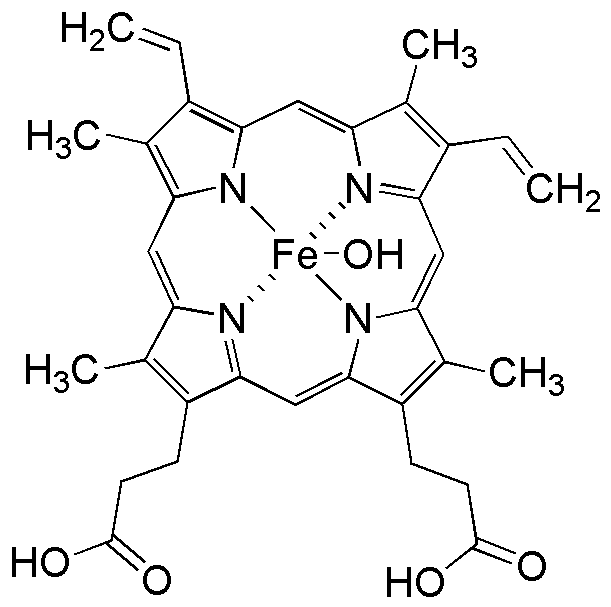Hematin is widely utilized in research focused on:
- Medical Diagnostics: Hematin is used in the diagnosis of certain blood disorders, particularly in the identification of porphyrias, which are conditions related to the production of heme. Its role in these tests helps clinicians understand and treat these conditions effectively.
- Pharmaceutical Development: In drug formulation, hematin serves as a key component in the development of therapies for conditions like sickle cell disease and thalassemia. Its ability to mimic natural heme makes it valuable in creating effective treatments.
- Biochemical Research: Researchers utilize hematin to study heme metabolism and its effects on various biological processes. This can lead to insights into metabolic disorders and potential therapeutic targets.
- Industrial Applications: In the textile industry, hematin is used as a dye due to its vibrant color properties. This application not only enhances the aesthetic appeal of fabrics but also provides a natural alternative to synthetic dyes.
- Environmental Science: Hematin is explored in bioremediation efforts, where it can help in the degradation of pollutants. Its ability to interact with various organic compounds makes it a candidate for cleaning up contaminated environments.
General Information
Properties
Safety and Regulations
Applications
Hematin is widely utilized in research focused on:
- Medical Diagnostics: Hematin is used in the diagnosis of certain blood disorders, particularly in the identification of porphyrias, which are conditions related to the production of heme. Its role in these tests helps clinicians understand and treat these conditions effectively.
- Pharmaceutical Development: In drug formulation, hematin serves as a key component in the development of therapies for conditions like sickle cell disease and thalassemia. Its ability to mimic natural heme makes it valuable in creating effective treatments.
- Biochemical Research: Researchers utilize hematin to study heme metabolism and its effects on various biological processes. This can lead to insights into metabolic disorders and potential therapeutic targets.
- Industrial Applications: In the textile industry, hematin is used as a dye due to its vibrant color properties. This application not only enhances the aesthetic appeal of fabrics but also provides a natural alternative to synthetic dyes.
- Environmental Science: Hematin is explored in bioremediation efforts, where it can help in the degradation of pollutants. Its ability to interact with various organic compounds makes it a candidate for cleaning up contaminated environments.
Documents
Safety Data Sheets (SDS)
The SDS provides comprehensive safety information on handling, storage, and disposal of the product.
Product Specification (PS)
The PS provides a comprehensive breakdown of the product’s properties, including chemical composition, physical state, purity, and storage requirements. It also details acceptable quality ranges and the product's intended applications.
Certificates of Analysis (COA)
Search for Certificates of Analysis (COA) by entering the products Lot Number. Lot and Batch Numbers can be found on a product’s label following the words ‘Lot’ or ‘Batch’.
*Catalog Number
*Lot Number
Certificates Of Origin (COO)
This COO confirms the country where the product was manufactured, and also details the materials and components used in it and whether it is derived from natural, synthetic, or other specific sources. This certificate may be required for customs, trade, and regulatory compliance.
*Catalog Number
*Lot Number
Safety Data Sheets (SDS)
The SDS provides comprehensive safety information on handling, storage, and disposal of the product.
DownloadProduct Specification (PS)
The PS provides a comprehensive breakdown of the product’s properties, including chemical composition, physical state, purity, and storage requirements. It also details acceptable quality ranges and the product's intended applications.
DownloadCertificates of Analysis (COA)
Search for Certificates of Analysis (COA) by entering the products Lot Number. Lot and Batch Numbers can be found on a product’s label following the words ‘Lot’ or ‘Batch’.
*Catalog Number
*Lot Number
Certificates Of Origin (COO)
This COO confirms the country where the product was manufactured, and also details the materials and components used in it and whether it is derived from natural, synthetic, or other specific sources. This certificate may be required for customs, trade, and regulatory compliance.


